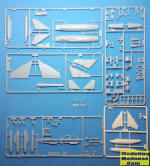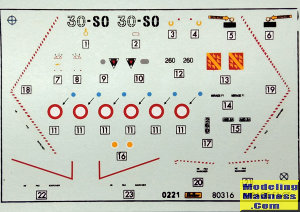
Heller 1/72 Mirage F.1CT
| KIT #: | 80316 |
| PRICE: | $12.00 when new |
| DECALS: | One option |
| REVIEWER: | Spiros Pendedekas |
| NOTES: |

| HISTORY |
The Dassault Mirage F1 is a French fighter and attack aircraft, developed as a successor to the Mirage III family. During the latter half of 1974, the Mirage F1 entered service in the French Air Force. Shortly thereafter, the type was deployed as the main interceptor of the French Air Force, a capacity which it continued to serve in until the arrival of the Mirage 2000. It later transitioned to an aerial reconnaissance role. In July 2014, the last French Mirage F1s were retired from service.
The type has been exported to around a dozen nations, having seen action in a large number of armed conflicts involving several of its operators. It is estimated that 726 examples of all variants and trainers were manufactured during its run between 1966 and 1992.
| THE KIT |
 Being
both a French and a leading plastic model company during the 70s, it was only
too natural for Heller to come up with a detailed Mirage F1 mold in 1978,
together with Airfix, which issued their own 1/72 Mirage F1 that year also.
Since then, Hasegawa in 1983, Esci in 1988 and, finally, Special Hobby in 2012
came with their own 1/72 renditions of the successful Dassault fighter, which
seems to be sufficiently served in this scale.
Being
both a French and a leading plastic model company during the 70s, it was only
too natural for Heller to come up with a detailed Mirage F1 mold in 1978,
together with Airfix, which issued their own 1/72 Mirage F1 that year also.
Since then, Hasegawa in 1983, Esci in 1988 and, finally, Special Hobby in 2012
came with their own 1/72 renditions of the successful Dassault fighter, which
seems to be sufficiently served in this scale.
Heller reboxed their Mirage F1 a dozen times, covering, with the introduction of extra parts, all sub-versions, including the two seater trainers. The specific kit is the “CT” version 1998 reboxing, which was handed to me by a good friend, asking me to build it in less a week, in order to present it to one of our city’s Officials who was responsible for establishing a very nice war museum in our city, wιτη a retired Greek Mirage F1 being one of its exhibits!
The kit comes in a medium sized top opening box, featuring a dramatic box art by artist Serge Jamois, depicting two examples taxiing in Bangui M' Poko International Airport of the Central African Republic in 1997. Upon opening the box I was greeted with 76 light gray styrene parts, arranged in four equally sized sprues (which comprise the base kit) and one small off-white styrene sprue, containing the specific parts for this kit’s version. All sprues were loosely floating within the box, meaning irritating scratches, especially to the transparencies.
General shapes of parts look correct, while molding of the light gray styrene parts is typical late 1970s, exhibiting some flash and with the details tad on the soft side. A couple of sink marks were noted in some thick parts , as well as a few ejector pin marks at the door innards. The raised panel lines are quite extensive and at the correct places, tad on the heavy side, possibly needing some light sanding to tone them down. The extra off-white sprue (for the specific kit version) is sharply molded and has engraved details, meaning it was made with more recent molding technology.
Cockpit detail is not bad, including an average looking seat, a stick, an instrument panel and side consoles with raised instruments . The landing gear, a key element especially regarding the complex Mirage F1 main legs, is well represented, while the detail within the bays is average. The perforated air brakes are separately provided, with their perforations represented as indents. The intakes are well done, as is the exhaust. Finally, quite a bit of ordnance is provided, including external tanks and weapons, in case you resist the temptation to build the sleek bird in clean configuration.
The transparencies, though satisfactorily molded, suffered from the “non-bagging sprue syndrome” that many kit manufacturers used to treat us, mostly in the past, meaning they had minor scratches on them, obtaining a slightly foggy look.
Instructions are typical Heller, coming in the form of a four-leaf double sided A4 booklet, including a short history of the type, where the construction is spread in 11 steps, with a few of them being denser in information. Nothing really bad, just needing more careful study, Color callouts are given throughout.
 Only one
scheme is provided, for an Armée de l'Air bird operating in Bangui M' Poko
International Airport of the Central African Republic in 1997, with shades given
in Humbrol codes. Decals were well printed in my copy and looked usable, despite
their age.
Only one
scheme is provided, for an Armée de l'Air bird operating in Bangui M' Poko
International Airport of the Central African Republic in 1997, with shades given
in Humbrol codes. Decals were well printed in my copy and looked usable, despite
their age.
Instructions want you to first join the main fuselage halves with the dorsal framing on top, followed by the intakes, the ventral strakes and the exhaust. The wings are then assembled and attached, followed by the tailplanes and fin. The front fuselage section is next, where the cockpit is assembled and trapped between the front fuselage halves, followed by the two-piece nose and the nose landing gear, with the complete assembly attached to the main fuselage (be prepared for fit challenges there). Finally, the complex main landing gear is to be attached (where consulting a picture and a 3-view of the real thing will not be a bad idea), followed by the transparencies, ordnance and a few final bits, ending a build that certainly presents a certain degree of complexity.
| CONCLUSIONS |
Though more than 40 years old (as of 2024), this is still a decent model of the sleek Mirage F1 fighter, with general shapes of parts looking accurate and detail level being sufficient (towards good) in most areas. On the other hand, apart from the raised panel lines (which might not be a problem for a number of us), the molds start to show their age, with the complexity of construction classifying this kit towards the limited run category for today’s standards, meaning this is not for a beginner.
Regularly reboxed and sold at reasonable prices, if you have a few builds under your belt and want to build a Mirage F1, this is a kit worth tackling.
Happy Modeling!
Spiros Pendedekas
November 2024
Copyright ModelingMadness.com. All rights reserved. No reproduction in part or in whole without express permission of the editor.
If you would like your product reviewed fairly and fairly quickly, please contact the editor or see other details in the Note to Contributors.
Back to the Main Page Back to the Review Index Page Back to the Previews Index Page